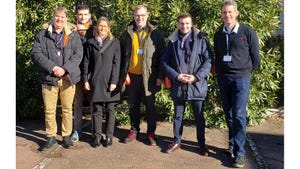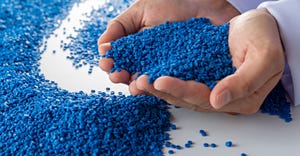Molding a medical niche in Southern California
July 1, 1997
On paper, American Technical Molding (ATM) might look like a typical custom molder. It operates out of a modest 50,000-sq-ft shop in Upland, CA, some 35 miles and several traffic jams east of Los Angeles. The company employs about 60 people, runs 23 presses, and molds medical disposables and device components. And with $7 million in annual sales, ATM isn't on the verge of bursting into the Fortune 500.
But in person, the story is different. ATM's attention to detail and its small size help it remain nimble and efficient in a market that is increasingly challenging, competitive, and cost-conscious. ATM is a custom molder, but does not buy into the low-bidder mentality, preferring instead to produce quality parts - for a price. "We're generally not the cheapest ones on the block," says president Rocky Morrison, "but we are the most cost-effective."
ATM is also unusual in that right next door is its sister company and primary moldmaker, JK Molds, a 26-year veteran of Southern California and a direct descendent of Caco Pacific via owner Jack Kelley. The two companies have grown up together and have developed a close working relationship that is not common in the industry.
The "T" in ATM
As the company's name implies, the molding at ATM is technical. With a Class 100,000 molding room, ATM's operations are spic and span and relatively complicated. Typical ATM molds are loaded with undercuts, multiple pulling cores, slides, and threads of every ilk. This ability to run complicated parts well has earned ATM a reputation in the industry as not only a quality production shop, but a lifesaver as well.
Morrison says that in its infancy during the late 1980s, ATM survived predominantly as the molder riding in on the white horse to save the dying mold. "A lot of customers think of us as the company of last resort," he says. Morrison is helped by his unique perspective. He and manager for technical sales and marketing, Walter Gacek, used to work for medical OEM McGaw. Says Morrison, "We understand the OEM's side of the fence."
Early on, some customers brought to ATM molding projects crippled by problems with the mold, material, or design. Morrison says mold and material problems are relatively simple to fix. But that's not where the bulk of the problems rest. "Very often, the problems we solve are violations of Design Basics 101," he says. "The most difficult problems to solve are those that involve product design."
Still, ATM dug many of its customers out of very deep holes, in the process winning the production responsibility for some of these recovered projects. This helped ATM develop into what it is today: half problem solver and half production shop. And more and more, ATM is called upon by OEMs to help prove out parts in research and development. "A lot of customers don't even want people to know they're working with us," says Morrison.
ATM's devotion to quality first is contrary to some custom molders' need to be low price. Some potential customers, says Morrison, don't recognize that molding is a science, not practiced equally by all, and shy away from ATM's higher prices. But for customers who are willing to pay for quality, the ends justify the means. "The cheapest is not always the best," he says. "We like to think we do things the right way. Our motto is that we do what it takes to make the customer happy."
On the Floor
ATM's propensity for technical and complicated molding, says Morrison, led the company to Sandretto. There are 23 Sandrettos in the cleanroom, ranging in size from 35 to 300 tons. Morrison says that Sandretto's ability to perform programmable, sequenced core pulls makes the press ideal for his shop. And they're quiet. Says Morrison, "Listen to our shop. You don't hear molds banging."
Material includes all of the usual suspects for medical products:
PC, PVC, acrylic, PEI, polysulfone, PE, and PP. Volumes range from a high end of 40 million to 50 million parts per year, to a low range of 5000 to 10,000 parts per year. Morrison says ATM practices decoupled molding, transferring on pressure read from the injection unit.
Over the press, automation is the norm, with robots extracting parts into sorters nested in portable Hepa-filtered air systems to blow out potential contaminants and maintain purity. Sprues and runners are conveyed through the wall for granulation in bays outside the cleanroom.
One family mold running during IMM's visit produces parts for a drug delivery device. The OEM for the part requests a bio burden of three bacteria colony forming units (CFU) or less per part, a strict standard ATM has not yet failed. This is accomplished with a Hepa-filtered air system and a separator that sorts parts by cavity, directly into plastic bags for shipping.
Across the aisle, a 165-ton Sandretto is pressing polycarbonate bodies for a needle-free syringe in a 16-cavity mold. Beside the press is an elaborate maze of chutes and tubes, into which a robot is dropping finished parts. Gacek says the contraption is an ATM brainchild and creation, devised to separate parts by cavity. The need for this device was prompted by the fact that the tip of the syringe body is only .003 inch in diameter. The core pins in the mold are unusually small and susceptible to damage. The flawed products a damaged pin produces are difficult to detect by simple visual inspection and may not be discovered for several minutes or hours. By segregating parts by cavity, when a core is damaged, ATM can pull just the affected parts, reducing scrap. "If we know that the core pin in cavity eight is damaged, then we dispose of only the parts produced in cavity eight," says Gacek.
The proof of ATM's abilities is generated in the quality control room adjacent to the molding floor. Gacek says the lab authorizes all parts before production, and uses part weight throughout production as an indicator of the stability of the process. "Sink on a part shows up on a weight SPC curve before it's visible to the eye," says Gacek.
In this room ATM also spent $100,000 over the last year on a Smart Scope vision measurement and inspection system from Optical Gaging Products. Gacek says the investment was considerable, but the payoffs enormous. "A manual inspection of a particular drug part we make used to take 5 hours," he says. "This scope does it in 5 minutes."
Although ATM sends SPC data and charts with each shipment, the molder's high quality and good reputation allow many customers to take product without inspection, knowing it meets specification. "ATM is dock-to-stock for several customers," says Gacek, "without incoming inspection." As a result, ATM's scrap rate is less than .25 percent.
The Moldmaker Next Door
Despite recent trends toward rapid tooling, Morrison says ATM prefers to proceed cautiously with each molding project. His reasoning is two-fold: first, the human body hasn't changed much in the last few thousand years - medical molds subsequently tend to last longer and should be made to endure; second, rapid tooling is not magic, it's just fast. "When it comes to tooling, people think magic is involved," says Morrison. "There are still just 24 hours in a day. It just means toolmakers are working overnight and on weekends." So ATM primarily uses paper drawings for design and tooling, and takes its time to produce a quality mold the first time.
More often than not, when it comes to moldmaking for ATM, JK Molds does the job. Although ATM and JK are separately managed, they are jointly owned and enjoy a close working relationship. As a result, ATM qualifies and proves out almost every mold JK makes. And occasionally, says Gacek, a qualification turns into full-blown production job for ATM. And ATM gets first dibs on any customer who comes to JK with a molding job. The relationship between the two companies, says JK president Terry Colbert, allows each to act independently when necessary, but still provide the one-stop service that is vital to many customers. "We get the best of both worlds," he says. "It gives us a real competitive edge."
ATM does have its own three-man moldmaking and maintenance shop in house - building one to two molds per month - but nothing compares to having a moldmaker right next door. JK, a Class A101 shop, employs 22 toolmakers, with an average of 20 to 30 years experience. The shop, which produces about 98 percent medical tooling, is a nice mix of new technology and traditional craftsmanship that's helped JK grow to a high-quality shop that's developed its own hot runner system and become a specialist in unwinding tools. "We don't follow fads and we don't buy anything brand new," says Colbert.
One thing new - but not brand new - is a centerpiece of the shop. It's a Roku-Roku graphite electrode machining center, one of the fastest in the industry and alleged to be the only one in operation west of the Mississippi River. With a maximum contour cutting speed of 315 inches/minute, the Roku-Roku is expected to keep JK's CNC center hopping.
The big eye-catcher at JK is its Shrinkmold system, a proprietary hot runner design that allows high-cavitation molds to run in smaller machines. The design reduces the projected area behind the cavities; this allows cavities to fit in a smaller space, reducing the overall size of the mold. It's also designed to hold higher pressures better, eliminating blowouts. JK also reports that the design allows fast color changes - in 10 to 20 shots. Of particular interest is a 16-cavity mold for a proprietary commercial product that uses the JK hot runner system. It ultimately will be half of a stack mold running in a 300-ton press.
JK also reports it made a 128-cavity mold with its hot runner system and that it, too, ran in a 300-ton machine. Although such a system appears to have good commercial potential, JK is playing its hot runner cards close to the chest. "It needs a track record before we get too far ahead with it in the field," says Colbert.
Back at ATM, the 16-cavity mold is being qualified for JK on a 300-ton Sandretto, with hopes of winning full production responsibilities. With all of its qualifying work, Morrison says ATM will add two machines later this year strictly for mold testing. Beyond that, he says, growth is controlled and steady. Morrison says ATM prefers its low profile and agility as a small, well-run, clean shop where everyone knows everyone else. "For custom molding, bigger is not always better," he says.
American Technical MoldingUpland, CA
Square footage: | 50,000 |
Markets served: | Medical |
Annual sales volume: | $7 million |
Annual resin usage: | 1.7 million lb |
Major customers: | Divisions of Abbott, Baxter, McGaw, Johnson & Johnson |
Materials processed: | PC, PVC, acrylic, PEI, polysulfones, PE, PP |
Annual parts production: | 250 million |
No. of employees: | 60 |
Shifts worked: | Three shifts, five to seven days a week |
Molding machines: | 23 Sandrettos, 35 to 300 tons |
Secondary operations: | Ultrasonic welding, pad printing, UV-cure adhesives, assembling, annealing, hot stamping |
Internal moldmaking: | Yes |
Quality: | ISO 9002, Class 100,000 molding cleanroom, Class 10,000 assembly cleanroom |
You May Also Like


